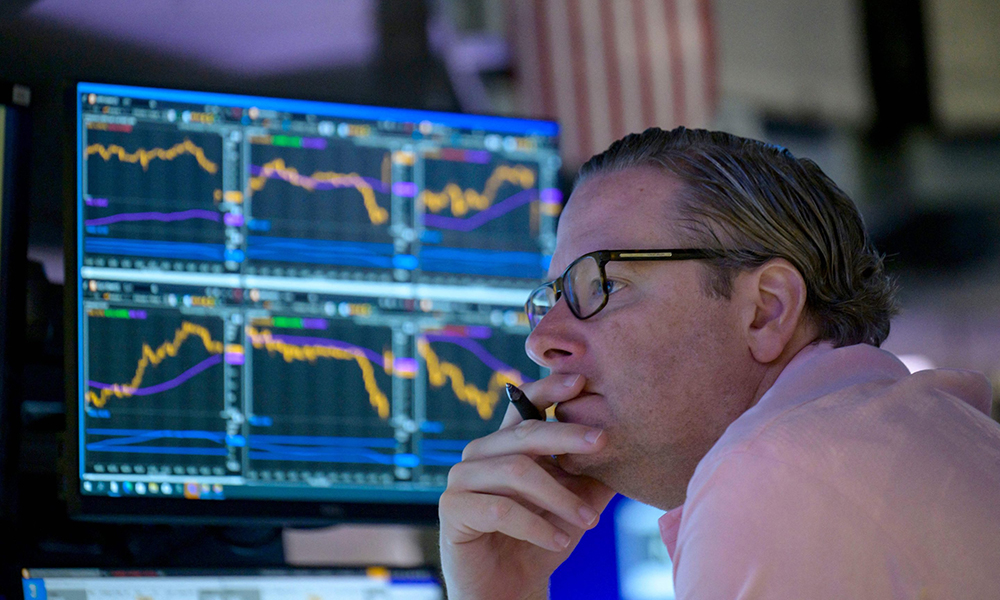华尔街资深投资者称,这个预示经济衰退的指标已经在示警

华尔街的分析师和投资策略师喜欢使用“经济衰退指标”。这些简单的统计数据作为(潜在的)迫在眉睫的经济灾难的证据,可能是管控风险的重要工具。以最重要的指标之一收益率曲线(yield curve)为例。自1969年以来,美国每次经济衰退之前都发生了收益率曲线倒挂。
收益率曲线用图表的方式展现了相关债券的收益率之间的关系,其中最常见的是美国10年期国债和2年期国债。短期债券的收益率通常低于长期债券,因为投资者将资金进行长期投资需要承担更多的风险。这种关系表现出来的是一种上升曲线。但有时候可能发生收益率曲线倒挂,这意味着长期债券的收益率低于短期债券的收益率。
Verdence Capital Advisors的首席投资官梅根·霍内曼在6月26日警告称,即使经过近一年之后,投资者也不应该对这个“历史衰退指标”感到“自满”。
这位华尔街资深投资者于6月26日在她的《每周投资洞察》(Weekly Investment Insights)报告中解释道:“历史上,通常在发生收益率曲线倒挂约15个月后,就会正式进入经济衰退。将这个期限用于当前发生的收益率曲线倒挂(约一年前)可以看出,美国经济可能在今年10月进入衰退。”
霍内曼在加入Verdence之前,曾经在德意志银行(Deutsche Bank)任职超过十年。她指出,收益率曲线倒挂和“其他许多经济信号”证明,今年下半年发生经济衰退几乎是“不可避免的”。
问题是,虽然自1969年以来每次经济衰退之前都会出现收益率曲线倒挂,但并非每一次收益率曲线倒挂之后都发生了经济衰退。过去的六次收益率曲线倒挂都准确预测了经济衰退,但有一个重要的例外:2022年3月,俄乌冲突爆发引起投资者恐慌之后出现的短暂收益率曲线倒挂。
什么是收益率曲线,为什么它如此可怕,霍内曼从这些信号中到底看到了什么?
预测未来
收益率曲线倒挂通常表明投资者正在将资金从短期债券投入到长期债券,因为他们预测经济活动短期下滑将迫使美联储(Federal Reserve)降息。实质上,它表明市场对经济前景变得日益悲观。这正是2022年7月5日所发生的状况:国债收益率曲线(10年期国债和2年期国债的收益率差额)倒挂,并持续至今。
除了这个表明市场信心下降的信号以外,霍内曼指出,世界大型企业研究会(Conference Board)的先行经济指数(Leading Economic Index),在今年5月降至自2020年7月以来的最低水平,现在已经连续14个月下降。先行经济指数使用的数据包括建筑许可、平均每周工作时间、制造商新订单数等数据,并以此来预测经济健康状况。
除此之外,虽然美国的年同比通货膨胀率从2022年6月创四十年新高的9.1%,下降到今年5月的只有4%,但美联储主席杰罗姆·鲍威尔于6月下旬在每半年一次的国会听证会上却发表了鹰派言论,承诺会继续应对通货膨胀。他在提到美联储2%的通胀目标时说:“通胀压力依旧居高不下,将通货膨胀降低到2%仍然有很长的路要走。”
霍内曼表示,这番言论表明,今年美联储还会再进行两轮加息,而且她认为要想在加息的过程中避免经济衰退,“历史并不站在我们这一边”。她在6月20日的报告中解释道:“历史告诉我们,美联储的大多数紧缩周期并不能实现软着陆。从表中可以看出,在过去的11个紧缩周期中,除了3个紧缩周期以外,其他紧缩周期均导致了经济衰退。”
市场警告信号?
经济衰退对股市而言绝非好消息。经济衰退会降低经济增速,增加失业,这反过来会伤害公司的收益。霍内曼在6月26日警告称,除此之外,今年的市场反弹与历史趋势相比只是一波异常行情,这可能意味着,未来会有“更多下跌”。
历史上,收益率曲线降至历史最低水平后的12个月,标准普尔500指数(S&P 500)的平均涨幅只有4.4%。但在3月8日收益率曲线降至历史最低水平(-108基点)后的短短几个月,该蓝筹股指数已经上涨了近9%。
霍内曼写道:“在美联储即将结束紧缩周期这种乐观心态的刺激下,股票估值持续上涨。然而,同样值得注意的是,历史上股市会在进入经济衰退之后才触底。”
这位首席投资官进一步表示,今年上半年的股市反弹并非“可持续的行情”,他预测“随着投资者开始面对现实的利率、经济和收益环境,股市会下跌10%至15%”。(财富中文网)
译者:刘进龙
审校:汪皓
华尔街的分析师和投资策略师喜欢使用“经济衰退指标”。这些简单的统计数据作为(潜在的)迫在眉睫的经济灾难的证据,可能是管控风险的重要工具。以最重要的指标之一收益率曲线(yield curve)为例。自1969年以来,美国每次经济衰退之前都发生了收益率曲线倒挂。
收益率曲线用图表的方式展现了相关债券的收益率之间的关系,其中最常见的是美国10年期国债和2年期国债。短期债券的收益率通常低于长期债券,因为投资者将资金进行长期投资需要承担更多的风险。这种关系表现出来的是一种上升曲线。但有时候可能发生收益率曲线倒挂,这意味着长期债券的收益率低于短期债券的收益率。
Verdence Capital Advisors的首席投资官梅根·霍内曼在6月26日警告称,即使经过近一年之后,投资者也不应该对这个“历史衰退指标”感到“自满”。
这位华尔街资深投资者于6月26日在她的《每周投资洞察》(Weekly Investment Insights)报告中解释道:“历史上,通常在发生收益率曲线倒挂约15个月后,就会正式进入经济衰退。将这个期限用于当前发生的收益率曲线倒挂(约一年前)可以看出,美国经济可能在今年10月进入衰退。”
霍内曼在加入Verdence之前,曾经在德意志银行(Deutsche Bank)任职超过十年。她指出,收益率曲线倒挂和“其他许多经济信号”证明,今年下半年发生经济衰退几乎是“不可避免的”。
问题是,虽然自1969年以来每次经济衰退之前都会出现收益率曲线倒挂,但并非每一次收益率曲线倒挂之后都发生了经济衰退。过去的六次收益率曲线倒挂都准确预测了经济衰退,但有一个重要的例外:2022年3月,俄乌冲突爆发引起投资者恐慌之后出现的短暂收益率曲线倒挂。
什么是收益率曲线,为什么它如此可怕,霍内曼从这些信号中到底看到了什么?
预测未来
收益率曲线倒挂通常表明投资者正在将资金从短期债券投入到长期债券,因为他们预测经济活动短期下滑将迫使美联储(Federal Reserve)降息。实质上,它表明市场对经济前景变得日益悲观。这正是2022年7月5日所发生的状况:国债收益率曲线(10年期国债和2年期国债的收益率差额)倒挂,并持续至今。
除了这个表明市场信心下降的信号以外,霍内曼指出,世界大型企业研究会(Conference Board)的先行经济指数(Leading Economic Index),在今年5月降至自2020年7月以来的最低水平,现在已经连续14个月下降。先行经济指数使用的数据包括建筑许可、平均每周工作时间、制造商新订单数等数据,并以此来预测经济健康状况。
除此之外,虽然美国的年同比通货膨胀率从2022年6月创四十年新高的9.1%,下降到今年5月的只有4%,但美联储主席杰罗姆·鲍威尔于6月下旬在每半年一次的国会听证会上却发表了鹰派言论,承诺会继续应对通货膨胀。他在提到美联储2%的通胀目标时说:“通胀压力依旧居高不下,将通货膨胀降低到2%仍然有很长的路要走。”
霍内曼表示,这番言论表明,今年美联储还会再进行两轮加息,而且她认为要想在加息的过程中避免经济衰退,“历史并不站在我们这一边”。她在6月20日的报告中解释道:“历史告诉我们,美联储的大多数紧缩周期并不能实现软着陆。从表中可以看出,在过去的11个紧缩周期中,除了3个紧缩周期以外,其他紧缩周期均导致了经济衰退。”
市场警告信号?
经济衰退对股市而言绝非好消息。经济衰退会降低经济增速,增加失业,这反过来会伤害公司的收益。霍内曼在6月26日警告称,除此之外,今年的市场反弹与历史趋势相比只是一波异常行情,这可能意味着,未来会有“更多下跌”。
历史上,收益率曲线降至历史最低水平后的12个月,标准普尔500指数(S&P 500)的平均涨幅只有4.4%。但在3月8日收益率曲线降至历史最低水平(-108基点)后的短短几个月,该蓝筹股指数已经上涨了近9%。
霍内曼写道:“在美联储即将结束紧缩周期这种乐观心态的刺激下,股票估值持续上涨。然而,同样值得注意的是,历史上股市会在进入经济衰退之后才触底。”
这位首席投资官进一步表示,今年上半年的股市反弹并非“可持续的行情”,他预测“随着投资者开始面对现实的利率、经济和收益环境,股市会下跌10%至15%”。(财富中文网)
译者:刘进龙
审校:汪皓
Wall Street analysts and investment strategists love to use “recession indicators.” These simple statistics that serve as evidence of (potential) impending economic disaster can be invaluable tools for managing risk. Just look at one of the most famous of them all: the yield curve. Since 1969, a yield curve inversion has preceded every U.S. recession.
The yield curve is a graphical representation of the relationship between the yields of related bonds—most commonly the U.S. 10-year Treasury and two-year Treasury. Typically, shorter-term bonds have lower yields than longer-term bonds because investors are taking more risk by locking up their money for longer. This relationship is represented by an upward sloping curve. But sometimes that yield curve can invert, meaning long-term bond yields drop below short-term bond yields.
Megan Horneman, chief investment officer at Verdence Capital Advisors, warned on June 26 that even after nearly a year, investors shouldn’t be “complacent” about this “historical recession indicator.”
“Historically, after the yield curve inverts, it takes ~15 months for the economy to officially enter a recession,” the Wall Street veteran explained in her Weekly Investment Insights research note on June 26. “Applying this same time frame to the current inversion (roughly one year ago), the economy could enter a recession in October of this year.”
Horneman, who spent more than a decade at Deutsche Bank before moving to Verdence, pointed to the yield curve inversion and “many other economic signals” as evidence that a recession in the second half of this year is now all but “unavoidable.”
The thing is, although every recession since 1969 has been preceded by a yield curve inversion, not every yield curve inversion has preceded a recession. The past six of them have all correctly predicted economic downturns, with a crucial exception: A brief inversion in March 2022 after Russia’s invasion of Ukraine spooked investors.
So what is the yield curve, why is it so scary, and what does Horneman see in the signals?
Reading the tea leaves
An inverted yield curve typically indicates that investors are moving money away from short-term bonds and into long-term bonds because they expect that a near-term decline in economic activity will force the Federal Reserve to cut interest rates. Essentially, it’s a sign that the market is becoming increasingly pessimistic about the economy’s prospects. And that’s exactly what happened on July 5, 2022, the Treasury yield curve (the difference between the yield of a 10-year Treasury and a two-year Treasury) inverted—and it’s remained that way ever since.
In addition to this signal of weak market confidence, Horneman noted that the Conference Board’s Leading Economic Index (LEI)—which uses data including building permits, average weekly hours worked, manufacturers’ new orders, and more to get a picture of the health of the economy—sank to its lowest level since July 2020 in May and has now fallen for 14 straight months.
On top of that, despite year-over-year inflation falling from its four-decade high of 9.1% in June 2022 to just 4% this May, Federal Reserve Chairman Jerome Powell delivered hawkish comments during his semiannual testimony on Capitol Hill in late June, promising to continue his inflation fight. “Inflation pressures continue to run high, and the process of getting inflation back down to 2% has a long way to go,” he said, referencing the central bank’s 2% inflation target.
Horneman said the comments are evidence of two more rate hikes on the way this year, and argued “history is not on our side” when it comes to avoiding a recession during a period of rising interest rates. “History tells us that most Fed tightening cycles do not end in a soft landing. As can be seen in the table, over the past 11 tightening cycles, all but three resulted in an economic recession,” she explained in a June 20 note.
A warning sign for markets?
Recessions are never good news for stocks. They slow economic growth and increase unemployment, which hurts corporate earnings. And Horneman warned on June 26 that, on top of that, this year’s market rally was an anomaly compared with the historical trend, which could mean there’s “additional downside” ahead.
Historically, after the yield curve falls to its lowest level, the S&P 500 has posted an average gain of just 4.4% in the following 12 months. But the blue-chip index is already up nearly 9% in just the few months since the yield curve reached its lowest level (–108 basis points) on March 8.
“Equity valuations continue to rise on the optimism that the Fed may be near the end of their tightening cycle,” Horneman wrote. “However, it is also important to remember that equity markets historically do not bottom until we are within a recession.”
The CIO went on to argue that the first half stock market rally this year is not “sustainable” and said she expects to see a “10% to 15% decline when investors become realistic with the interest rate, economic and earnings environment.”













